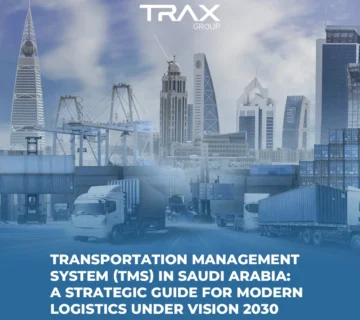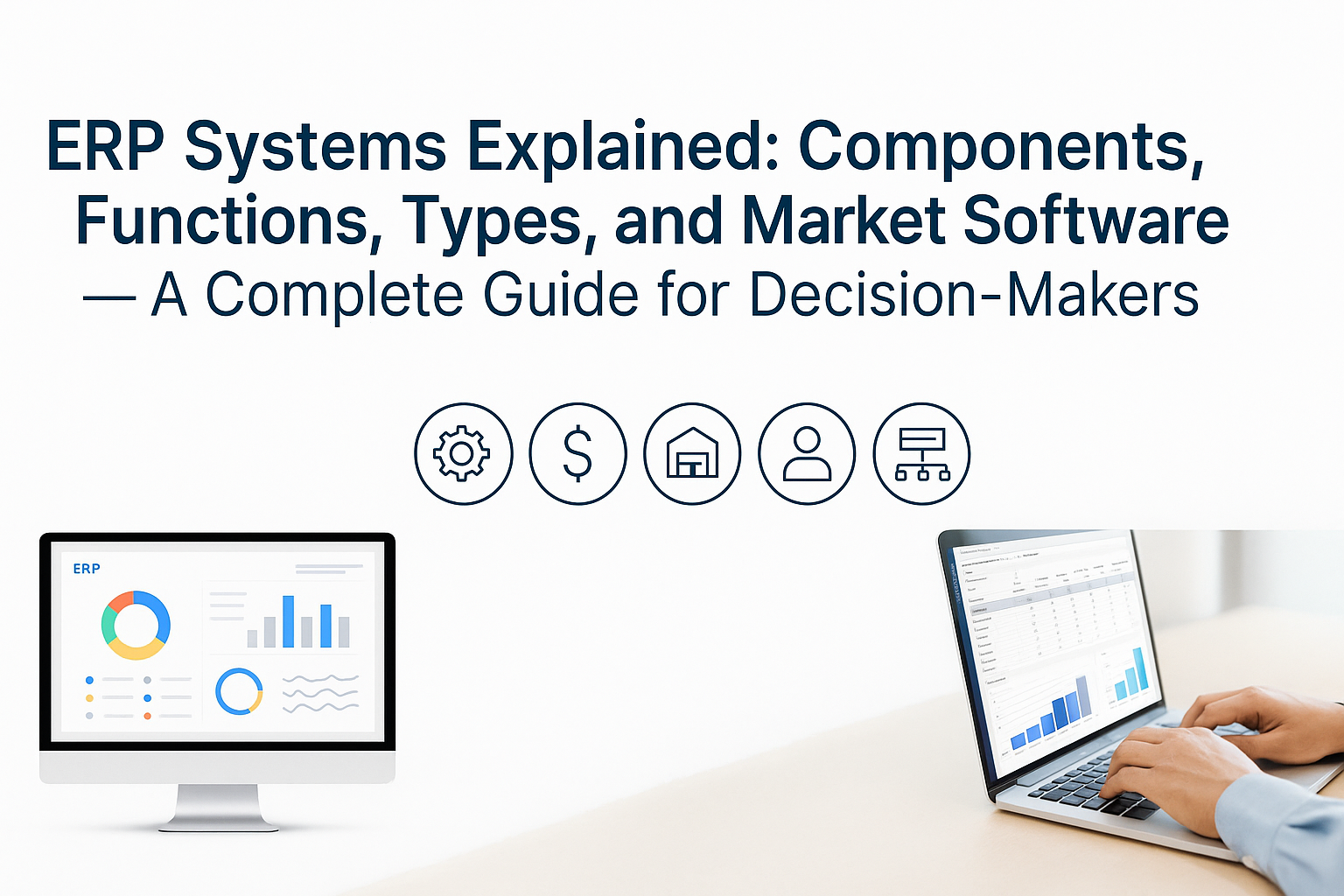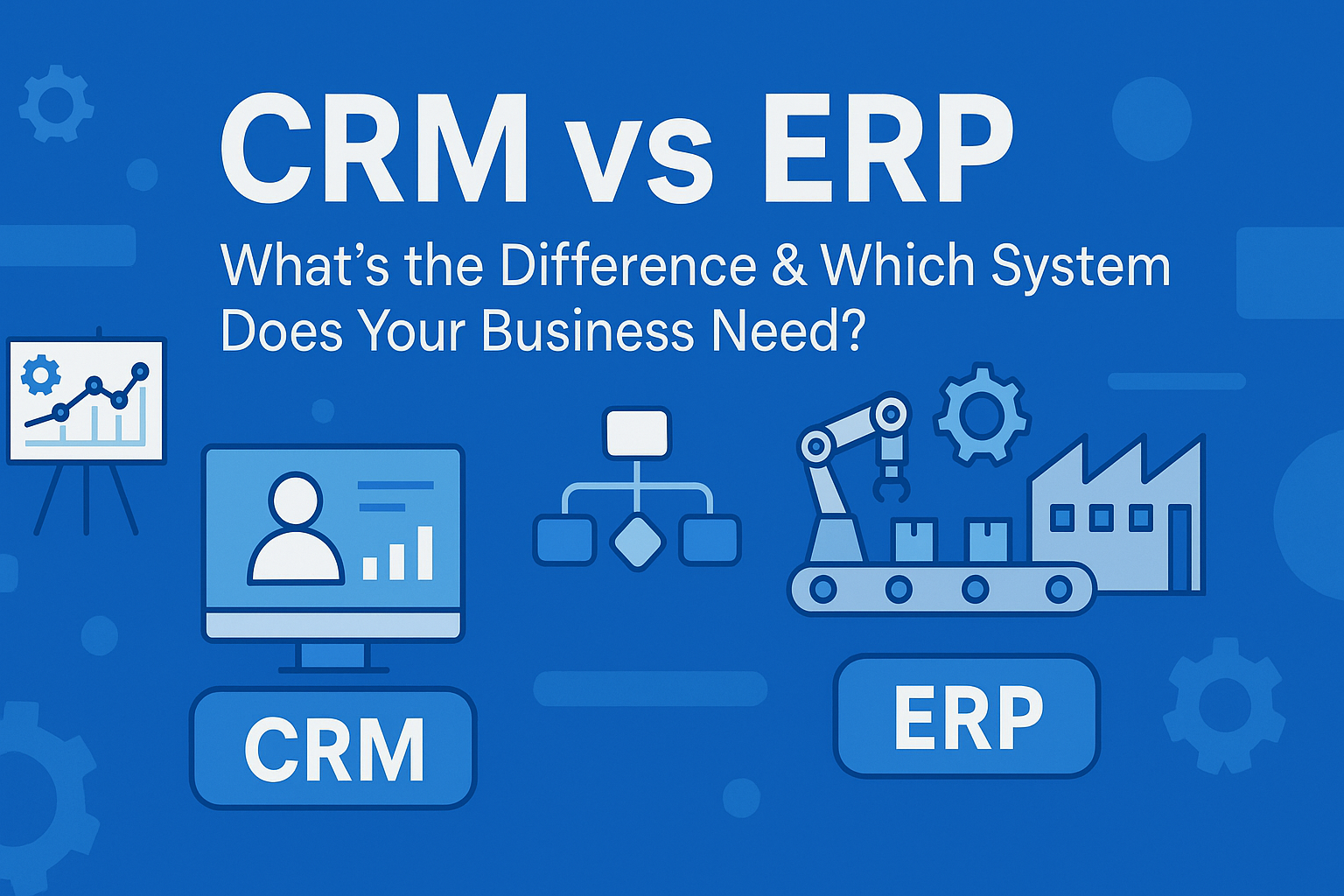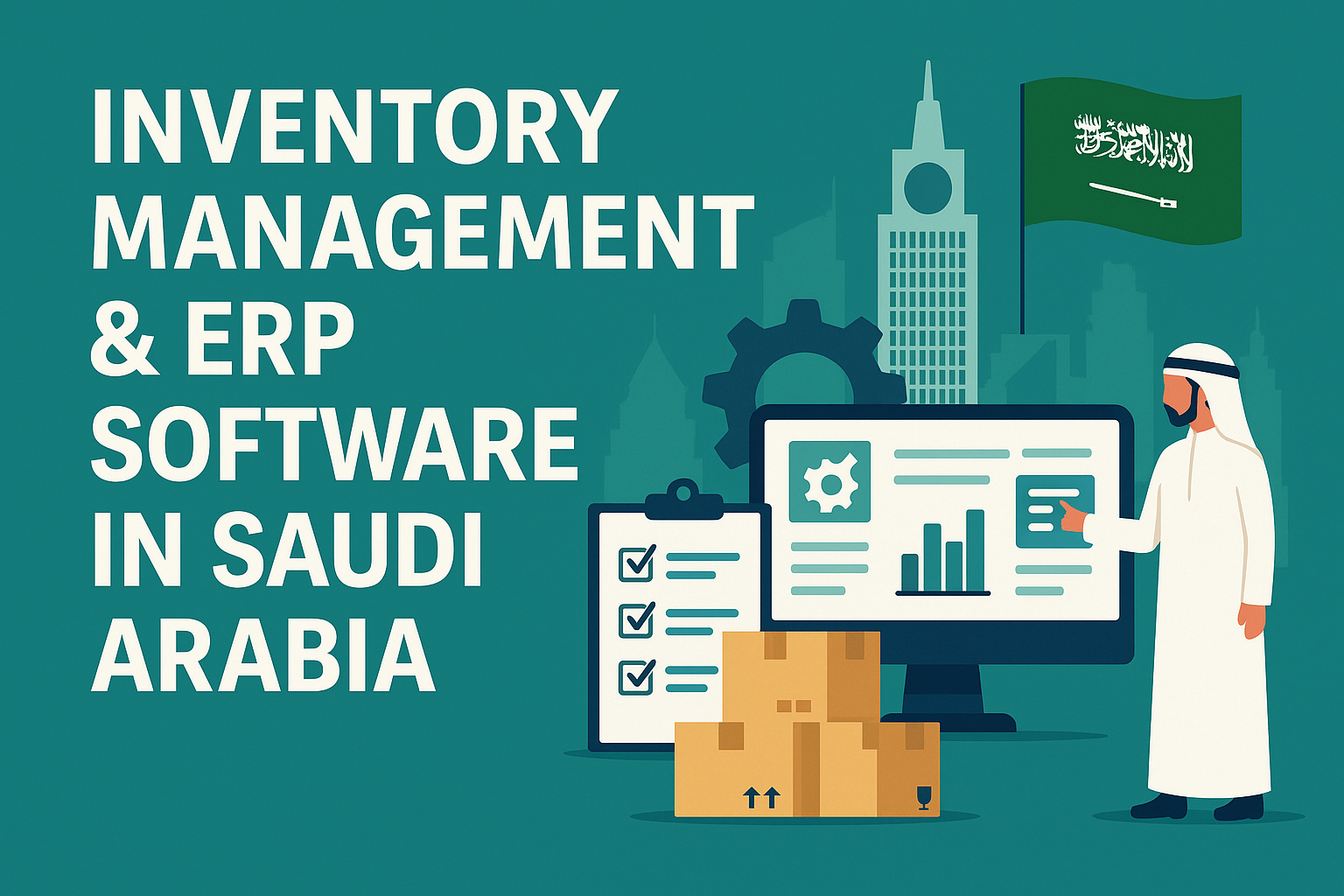Table of Contents
ToggleBusinesses in the Kingdom of Saudi Arabia are rapidly transforming due to technological advancements, regulatory changes, globalization, and the national Vision 2030 agenda. Enterprise Resource Planning (ERP) software is at the heart of this transformation: integrated systems that combine finance, operations, supply chain, human resources, and analytics into a single platform. This article looks at why an ERP system is important in Saudi Arabia, how the market is changing, what key features to look for, the benefits and challenges, how to choose the best solution, and what the future holds for Saudi ERP software.
Why ERP Software in Saudi Arabia Matters
Business Complexity and Growth
Saudi organizations are facing ever-increasing complexity—growing scale, expanded geographies, multiple business lines, digital channels, supply-chain demands, and stringent compliance. An ERP system in Saudi Arabia enables companies to unify disparate processes, standardize operations, and gain visibility across departments.
Regulatory and Localisation Needs
ERP software in Saudi Arabia must support specific local regulatory requirements — for example, the Zakat, Tax and Customs Authority (ZATCA) e-invoicing mandates and VAT rules. Also, localization in terms of the Arabic language, right-to-left interfaces, Saudi working-culture norms, and integration with local financial/HR systems is essential.
Digital Transformation & Vision 2030
Saudi Arabia’s Vision 2030 initiative emphasizes digitalization, economic diversification, and building a knowledge-based economy. ERP software is a backbone technology for enabling digital transformation—automating operations, enabling analytics, and supporting cloud and mobile access. The ERP market in the Kingdom is projected to grow significantly.
Efficiency, Visibility and Agility
With an ERP system, Saudi businesses can reduce manual work, minimize data silos, enhance reporting accuracy, and make faster data-driven decisions. In an increasingly competitive and globalized market, such capabilities provide a strategic edge.
The ERP Software Market in Saudi Arabia: Overview & Trends
Market Size & Growth
The Saudi Arabian ERP software market was estimated at around USD 416.7 million in 2024, and is projected to reach USD 1.625 billion by 2033, at a CAGR of approximately 15.2%. Grand View Research
The growth drivers include government mandates, increased cloud adoption, digital transformation programs, and rising demand from SMEs. Deployment is shifting from on-premises to cloud-based ERP systems. Grand View Research+1
Deployment Trends: Cloud vs On-Premises
While on-premises ERP systems still retain significance (especially in large enterprises), there is a clear shift toward cloud-based deployments—driven by lower infrastructure costs, agility, scalability, and remote-access capabilities. Grand View Research+1
Functional Priorities
Among the functions within ERP, the finance segment held the largest revenue share in 2024 (≈ 28.4 %). Grand View Research HR modules are expected to grow faster, driven by Saudization requirements and labor law changes.
Key Market Drivers
Regulatory compliance (VAT, e-invoicing, Saudization) is forcing businesses to modernize ERP systems. Grand View Research+1
Need for operational efficiency, real-time insight, and process standardization.
Expansion of SMEs and start‐ups needing affordable ERP systems.
Growth of the digital economy, smart manufacturing, logistics hubs, and regional trade.
Challenges and Risks
Despite the growth, ERP adoption in Saudi Arabia faces challenges:
High cost of implementation and customization.
Change-management issues, user adoption, and data migration complexity.
Need for localization and an Arabic interface, which some global ERP systems may not fully support.
Customization vs. standardization trade-off: excessive customization increases cost/time and complicates upgrades.
Key Features of an Effective ERP System in Saudi Arabia
When evaluating ERP software in Saudi Arabia (or an ERP system in Saudi Arabia), certain features should be considered to ensure fit, value, and future readiness.
1. Localisation & Regulatory Compliance
Support for the Arabic language and right-to-left user interfaces.
Compliance with Saudi tax laws, e-invoicing (ZATCA), Saudization, and WPS (Wage Protection System).
Localization of chart of accounts, financial reporting in line with Saudi GAAP or IFRS, local currency, and tax setups.
2. Modular & Scalable
Ability to adopt modules stage by stage (finance, HR, supply chain, manufacturing) rather than big bang.
Scalability to support growth: new business units, geographies, multiple legal entities, and multi-currency.
Cloud deployment and flexible licensing for SMEs and large enterprises.
3. Integration & Unified Data
Centralized database: finance, operations, HR, sales, and procurement all share data.
Integration with other systems: CRM, IoT, analytics, and external logistics/warehouse systems.
Real-time data flow and visibility across departments.
4. Analytics, Reporting & Intelligence
Dashboards, KPIs, and real-time insights for executives and operations.
Predictive analytics: forecasting, demand planning, inventory optimization.
Role-based views and mobile access.
5. Process Automation & Standardisation
Standard best-practice business processes out of the box customized for the Saudi context.
Automation of repetitive tasks (invoicing, approvals, and procurement workflows).
Compliance workflows and audit trails.
6. Flexible Deployment (Cloud/Hybrid) & Mobile Access
Cloud/SaaS models to reduce upfront infrastructure cost.
Hybrid/on-prem for organizations with regulatory or data sovereignty concerns.
Mobile apps, remote access: work from anywhere, support field/warehouse operations.
7. Industry-Specific Capabilities
For sectors in Saudi Arabia (oil & gas, manufacturing, construction, retail, logistics), the ERP must support industry-specific features.
For example: project-based costing, manufacturing execution, asset management, and distribution and retail modules.
8. Ease of Implementation & Support
Local partner ecosystem, Saudi-domain expertise, Arabic support.
Training, change-management services, and data-migration tools.
Upgrades and future-proofing (avoid heavy customization that blocks upgrades).
9. Security & Compliance
Support for Saudi cybersecurity regulations, data protection laws (PDPL), encryption, and role-based access.
Cloud providers must meet global standards (ISO 27001, SOC 2) as well as local regulatory requirements.
How Saudi Companies Should Select an ERP System
Selecting the right ERP software in Saudi Arabia is a strategic decision. Here is a recommended approach:
Step 1: Define Business Objectives & Needs
Map current pain points: manual processes, data silos, inefficient supply chain, and lack of visibility.
Outline goals: cost savings, process standardization, growth enablement, and compliance readiness.
Consider growth plans: new products, geographies, and M&A.
Step 2: Create Requirements & Prioritise
Prepare a list of required modules (finance, HR, supply chain, manufacturing).
Identify must-have features: Arabic language, local compliance, cloud/hybrid, and mobile access.
Prepare wish-list features: AI/analytics, IoT, workflow automation, and industry-specific modules.
Step 3: Evaluate Vendors/Solutions
Shortlist vendors that operate in Saudi Arabia, preferably with local implementation partners.
Request live demos and trial access with your data and process flows.
Evaluate localization, scalability, support, and cost structure (licensing, implementation, and recurring).
Check references of similar Saudi businesses that implemented the system.
Step 4: Consider Implementation & Change Management
Prepare for data migration: legacy systems, cleaning, and mapping to the new data model.
Plan change management: training, communication, and roles/responsibility changes.
Consider phased vs. big-bang implementation. Smaller pilots may reduce risk.
Step 5: ROI & Total Cost of Ownership (TCO)
Estimate total cost (software, hardware/cloud, services, training, and maintenance).
Estimate expected benefits: process efficiency, cost savings, improved revenue, and faster decision-making.
Define KPIs to measure success both during and after implementation.
Step 6: Go-Live & Post-Implementation Review
Execute the cutover carefully; monitor the system for issues.
Post-go-live support, user feedback, and gap analysis.
Continuous improvement: tune processes, add modules, and refine reporting.
Benefits of ERP Systems in the Saudi Context
Operational Efficiency & Cost Reduction
An ERP system in Saudi Arabia streamlines operations, eliminates duplicates, automates tasks, and reduces errors—freeing up staff for value-added activities.
Improved Visibility & Decision Making
Unified data and analytics enable business leaders to make informed decisions quickly—whether in finance, operations, HR or supply-chain.
Better Compliance & Governance
With the regulatory environment becoming more stringent in Saudi Arabia (tax, Saudization, e-invoicing), ERP helps manage compliance, audit trails, and reporting.
Support for Growth & Scalability
Whether expanding business units, entering new markets, acquiring companies, or launching new products, an ERP system provides the backbone to scale without breaking processes.
Enhancement of Competitive Advantage
Companies that modernize their operations through ERP systems stay ahead in productivity, responsiveness, and customer service—crucial in a globalized, digital era.
Industry-Specific Benefits
In sectors like manufacturing, construction, retail, or logistics—prevalent in Saudi Arabia—ERP systems provide specialized modules (manufacturing execution, project costing, and warehouse automation) that deliver targeted value.
Challenges Unique to Saudi Arabia & How to Overcome Them
Implementation Costs & Complexity
High upfront costs, long implementation timelines, and complex migrations are major hurdles. Mitigation: Consider cloud/SaaS models, phase implementation, and choose local-expert partners.
Localisation & Customisation Trade-Off
While global ERP systems offer wide coverage, they may lack full Arabic/RTL support or Saudi regulatory alignment. Conversely, heavy customization may hamper upgrades and increase cost. Mitigation: Choose solutions with strong pre-built localization and keep customizations minimal.
Change Management & User Adoption
Resistance to change among users, lack of training, and poor stakeholder engagement can lead to failure. Mitigation: Invest in training, involve end-users early, and show value early via pilot modules.
Data Migration & Legacy Systems
Migrating old systems, multiple spreadsheets, legacy software into the new ERP is complex and error-prone. Mitigation: Cleanse data ahead of time, map processes clearly, and run pilot migrations.
Customization vs. Standardization
Over-customization may lead to upgrade issues and higher maintenance costs. Standard processes may not fully fit business uniqueness. Mitigation: Adopt ‘configure-not-customize’ where possible; focus customization only where absolutely necessary.
Skills & Resource Gaps
ERP projects need expertise (functional consultants, technical staff, and change management). The local talent pool may be limited. Mitigation: Work with experienced partners, provide training, and plan for knowledge transfer.
Case Considerations: SMEs vs Large Enterprises in Saudi Arabia
SMEs (Small and Medium Enterprises)
SMEs often prefer solutions that are affordable, quick-to-deploy, cloud-based, and low-maintenance. For them, modular ERP SaaS with minimal customization is often ideal. Localization and Arabic support matter significantly.
Their constraints: limited budget, fewer internal IT resources, and need for standard processes rather than complex customization.
Large Enterprises & Multinationals
Large organizations might require full-scale ERP systems, support for multi-entity/multi-country, complex manufacturing/supply-chain modules, heavy analytics, and hybrid on-prem/cloud deployments.
Challenges: higher cost, longer deployment, change management across business units, integration of legacy systems, and custom modules for industry.
They must focus on alignments, project governance, and ensuring the ERP is an enabler of strategy, not just a transactional system.
Emerging Technologies & the Future of ERP in Saudi Arabia
Cloud, SaaS & Subscription Models
ERP software in Saudi Arabia is increasingly delivered via cloud or SaaS. This trend offers faster deployment, lower upfront CAPEX, automatic updates, and remote access.
Artificial Intelligence, Machine Learning & Analytics
ERP systems are integrating AI/ML for predictive insights, demand forecasting, anomaly detection, and workflow automation. The Saudi market is moving in that direction.
Internet of Things (IoT) & Edge Integration
Especially in the manufacturing, logistics, and energy sectors, ERP systems will increasingly integrate IoT data (sensors, equipment monitoring) for real-time operations, maintenance, and supply chain optimization.
Mobile & Remote Work
With workforce mobility evolving, ERP systems must support mobile access, remote workflows, tablets/smartphones, and field operations.
Composable ERP & Micro-Services Architecture
Rather than monolithic systems, the future lies in modular, composable ERP where organizations pick best-of-breed modules and integrate via APIs.
Enhanced Industry Clouds & Vertical Solutions
ERP software in Saudi Arabia will increasingly offer industry-specific cloud-ERP editions tailored for sectors (oil & gas, manufacturing, retail, and public sector).
Localization for the Saudi Market
Deeper localization will matter: Arabic UX, local financial/HR/business-practice alignment, local data center hosting, compliance with Saudi cyber/data laws (e.g., PDPL), and regional ecosystem.
Section: How to Get Maximum Value from an ERP Implementation in Saudi Arabia
Define Success Metrics Early
Set KPIs like reduction in process time, improvement in reporting, cost savings, lead-time reduction, inventory turnover improvement, and compliance incident reduction.
Align Stakeholders
From executive sponsorship down to operational users, alignment of business vision, IT team, and vendor/partner is crucial.
Start with Clear Scope & Phased Approach
Avoid going too broad immediately. Consider implementing core modules first, then extend. This helps deliver early wins and reduces risk.
Focus on Business Process Re-Engineering
An ERP implementation is more than software; it often requires rethinking business processes. Use the implementation to standardize best practices.
Data Governance & Quality
Prioritize data cleansing, master data management, and common definitions across the business. Poor data quality can sabotage benefits.
Change-Management & Training
Provide role-based training, build internal champions, and use workshops, hands-on sessions, and communication to ease the transition.
Continuous Improvement
After go-live, monitor performance, gather feedback, refine processes, add modules, and make the ERP a living system that evolves with the business.
Partner and Vendor Selection
Choose a vendor/partner with deep experience in the Saudi market, Arabic support, localization capabilities, and a track record of successful ERP deployments in the Kingdom.
Final Thoughts
For organisations operating in Saudi Arabia, investing in an ERP system is no longer optional—it’s fundamental. With the market expanding rapidly, regulatory demands increasing, and the digital transformation imperative stronger than ever, the right ERP software in Saudi Arabia can be a differentiator between stagnation and growth.
Selecting the right system requires a clear understanding of your business needs, local nuances, implementation realities and future-readiness. Whether you are a small or medium enterprise seeking quick value, or a large complex organisation looking for a full-scale enterprise solution, there is a fit.
By focusing on localisation, modularity, analytics, integration, and change management, and by aligning your ERP strategy with Saudi Arabia’s evolving business landscape, you can position your organisation for operational excellence and strategic advantage.
Now is the time: evaluate, plan, execute and operate your ERP system in Saudi Arabia in a way that builds the future of your business.
ERP software in Saudi Arabia (Enterprise Resource Planning system) is an integrated business-management platform that connects finance, human resources, supply-chain, manufacturing, sales, and analytics in one unified system. It helps Saudi businesses automate workflows, ensure regulatory compliance (like ZATCA e-invoicing), and achieve operational efficiency across all departments.
ERP systems in Saudi Arabia are critical because they:
Centralize data for accurate decision-making.
Ensure compliance with local tax and labour regulations.
Support Arabic language and right-to-left interface.
Help organisations align with Saudi Vision 2030’s digital-transformation goals.
Improve efficiency, reduce costs, and enhance overall business visibility.
ERP systems are key enablers of Vision 2030. They help Saudi organisations digitize operations, increase productivity, improve transparency, and build a data-driven culture — all of which contribute to the national goal of economic diversification and sustainability.
Almost every major industry benefits from ERP software in Saudi Arabia, including:
Manufacturing and industrial production
Oil and gas
Retail and distribution
Construction and real estate
Logistics and supply-chain
Healthcare and education
Financial services and government entities
Each sector leverages ERP modules tailored to its specific workflows and compliance needs.
Key benefits include:
Streamlined business processes and automation.
Real-time visibility into financial and operational data.
Improved collaboration across departments.
Simplified compliance with ZATCA and VAT regulations.
Cost reduction through process standardisation.
Faster, data-driven decision-making.
Yes. Cloud-based ERP systems in Saudi Arabia are growing rapidly because they are cost-effective, scalable, and accessible from anywhere. Many organisations — especially SMEs — prefer cloud ERP to avoid heavy upfront investment in hardware and maintenance.








No comment